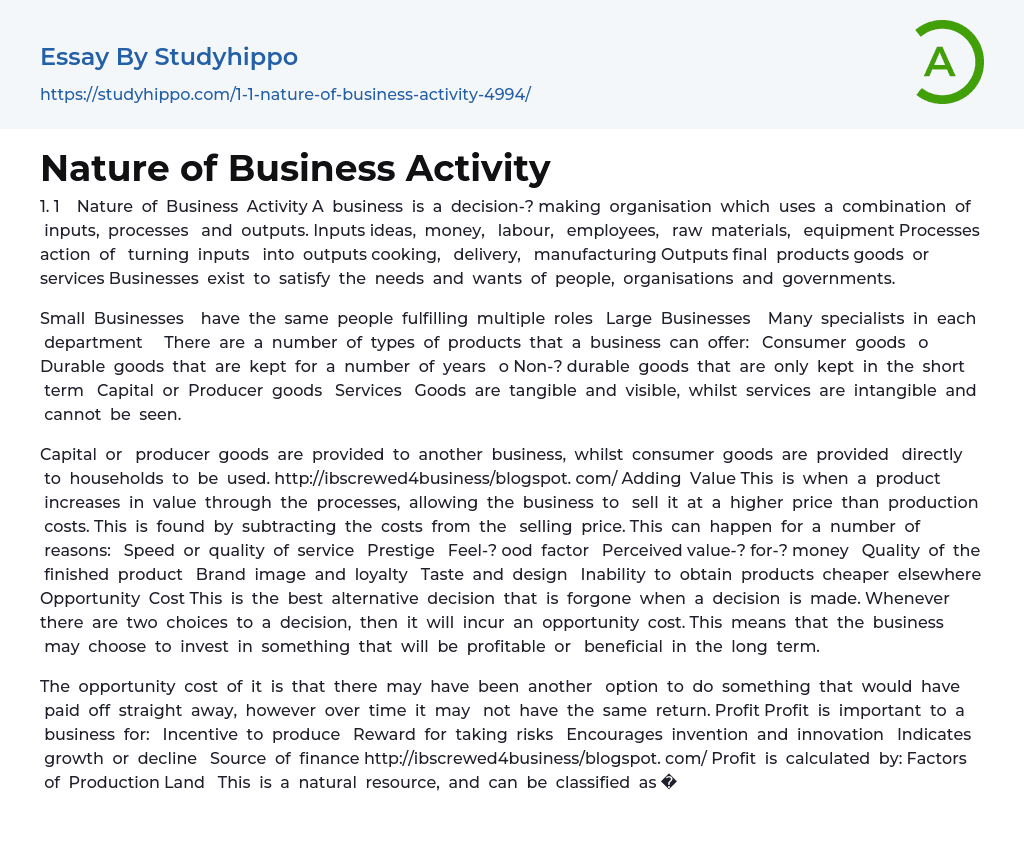1. The nature of a business activity is that it is a decision-making organization that utilizes a combination of inputs, processes, and outputs. The inputs include ideas, money, labor, employees, raw materials, and equipment. The processes involve the action of transforming these inputs into outputs through cooking, delivery, or manufacturing. The outputs are the final products in the form of goods or services. The purpose of businesses is to fulfill the needs and desires of individuals, organizations, and governments.
Small businesses often have the same individuals fulfilling multiple roles, while large businesses have many specialists in each department. There are various types of products that a business can offer, including consumer goods (both durable and non-durable) as well as capital or producer goods. Additionally, businesses can provide services. Goods are tangible and visible, whereas services are intangible and cannot be seen
....
Capital goods, also known as producer goods, are provided to another business, while consumer goods are provided directly to households for use. source
The act of adding value involves enhancing the worth of a product through various processes, enabling the business to sell it at a higher price than its production costs. This increase in value can occur due to factors such as the speed or quality of service, prestige, feel-good factor, perceived value-for-money, quality and design of the finished product, brand image and loyalty, taste and design preferences among consumers ,and an inability to find cheaper alternatives elsewhere.
Opportunity cost refers to the alternative decision that is foregone when making a choice. Whenever there are two options in a decision-making process, there will always be an opportunity cost associated with selecting one option over another. This
means that businesses may choose to invest in something that will prove profitable or beneficial in the long run.
The text discusses the concept of opportunity cost, which refers to choosing a different option that may have immediate benefits but potentially lower returns over time. It also highlights the importance of profit in business, as it serves as an incentive for production, rewards for taking risks, encourages innovation, and indicates growth or decline. Profit is calculated based on factors such as land (renewable or non-renewable used for various purposes), labor (physical and mental effort by employees), capital (resources used for product creation), and entrepreneurship (management and organization). Specialization occurs when a business focuses on producing specific goods or services, while individuals specialize in professions and departments focus on specific functions within organizations. Corporate specialization involves providing a limited range of products, regional specialization occurs when an area excels in a specific field, and national specialization happens when an entire country specializes in one area.
[Source: http://ibscrewed4business.blogspot.com/]Specialization brings several benefits like enhanced productivity, greater profit margins, improved efficiency, and standardization. However, it also comes with drawbacks such as boredom, inflexibility, limited autonomy, and high capital costs. The production and operations department oversees the manufacturing process of goods.
How it should be delivered Quality control Stock management Research and development Ordering and delivery of raw materials Marketing This department does market research and promotion of the business products Meeting customer wants and needs Using pricing strategies Promoting awareness of the product Making the product available to consumers
Finance This department takes care of providing, managing and recording financial resources.
Ensure other departments operate within budget. Recording all financial transactions. Human Resources. This department manages the business workforce. Recruitment and selection. Training and performing appraisals. http://ibscrewed4business/blogspot.com/. Sectors of Industry. Primary extracting, harvesting, and converting land resources are used in the secondary sector. Secondary converts raw materials into finished products. Tertiary, also called services, sells finished products and services to consumers.
- Advertising essays
- Audience Theory essays
- Competitor Analysis essays
- Consumer essays
- Marketing Management essays
- Marketing Mix essays
- Marketing Plan essays
- Marketing Research essays
- Marketing Strategy essays
- Point Of Sale essays
- Price essays
- Procurement essays
- Product essays
- Product Differentiation essays
- Promotion essays
- Promotion And Marketing Communications essays
- Retailing essays
- Trademark essays
- Anheuser-busch essays
- Brands essays
- Detergent essays
- Product Placement essays
- Research Design essays
- New Product Development essays
- Advertisement essays
- Brand essays
- Sales Promotion essays
- Advertising campaign essays
- Consumer behaviour essays
- Offer And Acceptance essays
- Wal-Mart essays
- Discover essays
- Accounting essays
- Andrew Carnegie essays
- Automation essays
- Business Cycle essays
- Business Intelligence essays
- Business Model essays
- Business Operations essays
- Business Software essays
- Cooperation essays
- Cooperative essays
- Corporate Social Responsibility essays
- Corporation essays
- Customer Relationship Management essays
- Family Business essays
- Franchising essays
- Harvard Business School essays
- Harvard university essays
- Human Resource Management essays




